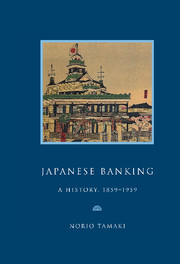Book contents
- Frontmatter
- Contents
- Preface
- Genealogy of leading Japanese banks, 1859–1959
- List of abbreviations
- Map
- Part I A bankrupt Shogunate, 1859–1868
- Historical background
- 1 Japanese merchant bankers: ryogae, 1859–1868
- 2 A bankrupt regime, 1859–1866
- 3 Ryogae struggling for survival, 1859–1868
- 4 The arrival of western banking, 1863–1868
- Part II The Meiji Restoration: monetary confusion and banking experiments, 1868–1881
- Part III Matsukata, the wizard of Japanese banking, 1881–1897; the Yokohama Specie Bank (1880) and the Bank of Japan (1882)
- Part IV The Japanese on the London money market, 1897–1911
- Part V War, the Japanese boom years, 1911–1919
- Part VI Crisis and the road to war, 1919–1937
- Part VII Complete commitment, struggle and defeat, 1937–1945
- Part VIII American ‘democratisation’ and the search for growth, 1945–1959
- An extraordinary century, 1859–1959
- Appendices
- Notes
- Bibliography
- Index
4 - The arrival of western banking, 1863–1868
Published online by Cambridge University Press: 03 February 2010
- Frontmatter
- Contents
- Preface
- Genealogy of leading Japanese banks, 1859–1959
- List of abbreviations
- Map
- Part I A bankrupt Shogunate, 1859–1868
- Historical background
- 1 Japanese merchant bankers: ryogae, 1859–1868
- 2 A bankrupt regime, 1859–1866
- 3 Ryogae struggling for survival, 1859–1868
- 4 The arrival of western banking, 1863–1868
- Part II The Meiji Restoration: monetary confusion and banking experiments, 1868–1881
- Part III Matsukata, the wizard of Japanese banking, 1881–1897; the Yokohama Specie Bank (1880) and the Bank of Japan (1882)
- Part IV The Japanese on the London money market, 1897–1911
- Part V War, the Japanese boom years, 1911–1919
- Part VI Crisis and the road to war, 1919–1937
- Part VII Complete commitment, struggle and defeat, 1937–1945
- Part VIII American ‘democratisation’ and the search for growth, 1945–1959
- An extraordinary century, 1859–1959
- Appendices
- Notes
- Bibliography
- Index
Summary
Western bankers did not immediately see any profitable business in Japan and did not arrive in Yokohama until the spring of 1863 when western merchants were becoming desperately short of specie. The first response to the demands came in March 1863 from the Central Bank of Western India with Charles Rickerby as the acting manager at Yokohama. A month later, in April 1863, the Chartered Mercantile Bank of India, London and China arrived in Yokohama. The manager of the Mercantile Bank, who had transferred himself from Hong Kong, wishfully reported that ‘the branch was likely to be successful’. Thus, the western banking invasion of Japan, which was to undermine the old order in Japan and was led by two British overseas banks, started on a modest scale. Before 1868 and the Meiji Restoration, another five banks were added to the number: Commercial Bank of India in September 1863; the Bank of Hindustan, China and Japan and the Oriental Bank Corporation in 1864; the brand new Hongkong and Shanghai Banking Corporation in 1866; and from France came Comptoir d'Escompte de Paris in 1867. These foreign banks had enormous assets if their capital stock is translated into Japanese ryo. The largest were Comptoir d'Escompte and the Oriental Bank with capital of more than 90 million ryo and 42 million ryo respectively.
The future of western banking in Yokohama remained, during the 1860s, problematical.
- Type
- Chapter
- Information
- Japanese BankingA History, 1859–1959, pp. 17 - 18Publisher: Cambridge University PressPrint publication year: 1995
- 2
- Cited by



